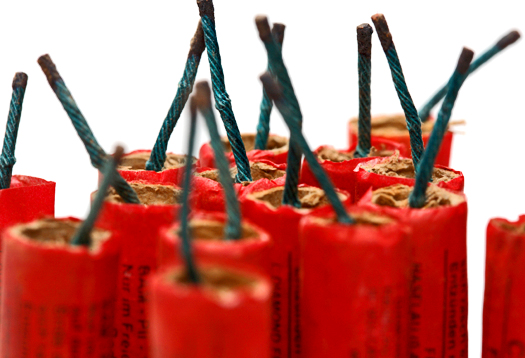Difference Between TNT and Dynamite

Majority of people take dynamite to be a colloquial term for TNT. That however, is a common misconception because there are a number of differences between TNT and dynamite. Physical appearance is the first major difference. Dynamite is commonly found in the form of a white crystal. TNT, on the other hand, is a yellow coloured crystal.
Swedish chemist Alfred Nobel discovered dynamite. The experiment that Nobel was trying to perform as make chemical nitroglycerin less explosive by making it more stable. The chemist prepared a mixture of nitroglycerin, sodium carbonate and diatomaceous earth. This mixture was patented as dynamite and was found to make chemical nitroglycerin more stable. On the other hand, TNT was discovered by Joseph Wilbrand in 1863.
Another difference is the stability of the two substances. Dynamite is less stable as compared to TNT. That being said, less stability of dynamite gives it more explosive power as compared to TNT. In terms of molecular mass and density, dynamite dominates TNT. As a matter of fact, dynamite is 60% denser than TNT. Another fact worth mentioning when making a comparison between dynamite and TNT is the difference in energy density. Energy density of the former is 7.5 M joules/Kg whereas for the latter it is only 4.6 M joules /Kg.
Transporting dynamite from one place to the other can be dangerous and difficult because of its tendency to be highly explosive. Furthermore, dynamite is one of those chemical substances which can not be used in pure form and for this reason have to kept in the form of a mixture. The same is not true in case of TNT.
Last, but not the least, TNT is much more poisonous than dynamite. Exposure to TNT for a long period of time can result in anaemia, abnormal liver functions and spleen enlargement. It can also cause discolouration of the human skin. However, when dealing with dynamite, there are no such hazards involved.
Instructions
-
1
TNT:
TNT stands for trinitrotoluene and is a chemical compound. Its chemical formula is C6H2(NO2)3CH3. TNT is mainly used in preparation of explosives primarily for industrial applications. There are a number of explosive blends which use TNT as an ingredient. Common examples of such blends are Amatex, Octol and Torpex.
Image courtesy: thetimes.co.uk

-
2
Dynamite:
Dynamite is a nitro-glycerine based material with highly explosive properties. The power of a dynamite explosion comes from detonation rather than deflagration. It has been manufactured in the US since 1970s.
Image courtesy: howstuffworks.com








